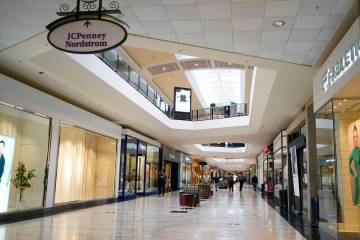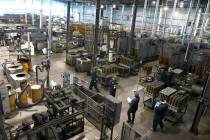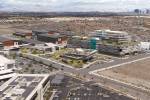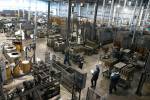Spending patterns shift, but sales tax receipts boom
Spending patterns have changed, but the end result is nearly the same.
Nevada closed in on boom-era taxable sales levels in April thanks in part to spending improvements in cars, electronics, home improvements and meals out. And where megaresorts on the Strip once powered the state’s construction economy, building has shifted to rural areas, where massive green-energy and utility projects are under way.
Businesses across Nevada sold $3.79 billion in goods in the month, the Nevada Department of Taxation reported Wednesday. That was up 7.3 percent from $3.53 billion in April 2012, and just 3.9 percent shy of the spending record for the month, set in 2006 at $3.94 billion. It also was 17.7 percent higher than the recession-era low of $3.22 billion, reached in 2009.
Clark County still has further to go to restore pre-downturn sales. Consumers and businesses bought $2.7 billion in goods in April, up 3.7 percent from $2.6 billion in April 2012, but down 8.6 percent from a high of $2.95 billion in April 2006. But the latest numbers were an 11.6 percent improvement over an April 2009 low of $2.42 billion.
The numbers were affected by a one-time refund that caused a $46 million downward swing in telecommunications. Without that tax credit, Clark County sales would have risen 5.5 percent.
Brian Gordon, a principal in local research and consulting firm Applied Analysis, said the statewide numbers point to continued overall improvement in the economy.
“While the spending profile may look different than it did during the peak of the market, the sheer sales volumes suggest the economy is pressing forward,” Gordon said.
All but roughly $11 million of the state’s $260 million sales gain came in just five counties. Churchill County surged mostly on a boom in construction of buildings. Humboldt County saw big gains in machinery manufacturing, while Nye County added $50 million in specialty trade contracting alone.
For privacy reasons, the Taxation Department doesn’t disclose specifics on purchases that boost taxable sales. But Churchill County is home to several major geothermal projects under construction, and Nye County claims the $1 billion Crescent Dunes solar project, under construction near Tonopah.
In Washoe County, home to Reno, and in Clark County, improvements came mostly from higher sales of cars and car parts, electronics and appliances, and home-improvement goods from retailers such as Home Depot and Lowe’s.
Clark County sales in commercial construction increased 4.7 percent to $44.8 million, though they were down nearly 70 percent from $148.7 million in April 2008.
The county’s single-biggest spending category, bars and restaurants, rose 5.9 percent year over year, to $779.8 million. Sales inside dealers of cars and car parts surged 17 percent. Other big gainers included building material and garden supply stores (up 50.9 percent), electronics and appliance stores (up 10.8 percent) and merchant wholesalers of durable goods such as office machines and appliances (up 10.6 percent).
Credit job growth of around 2 percent and rising home prices for the increases, Gordon said. Locals feel better about their job security, and higher home values mean more people have equity.
“They can see a light at the end of the tunnel,” he said. “They’ve been under water for so long, and they see price points trending upward. There’s a sense that they have the ability to reach back to where they once stood. Consumers are starting to resume some of the activities they held off on.”
Still, after more than a year of gains, some consumer-driven sectors slumped. Sales inside clothing boutiques and furniture stores dipped, while sales inside general merchandise stores were flat.
Ryan Kennelly, an economic analyst with UNLV’s Center for Business and Economic Research, said he expects taxable sales to continue increasing at 5 percent to 10 percent year over year into 2014. And with local homebuilders buying up land to develop new subdivisions, construction spending could strengthen as well. It’s “definitely possible” that Nevada returns to pre-recession sales levels in 2014, Kennelly added.
Sales and use taxes fund prisons and schools. For fiscal 2013, the General Fund share of sales and use taxes was 0.12 percent, or $938,000, below forecasts of the Economic Forum, a nonpartisan group that estimates revenue for state budgets.
Contact reporter Jennifer Robison at jrobison@review journal.com or 702-380-4512. Follow @J_Robison1 on Twitter.




























